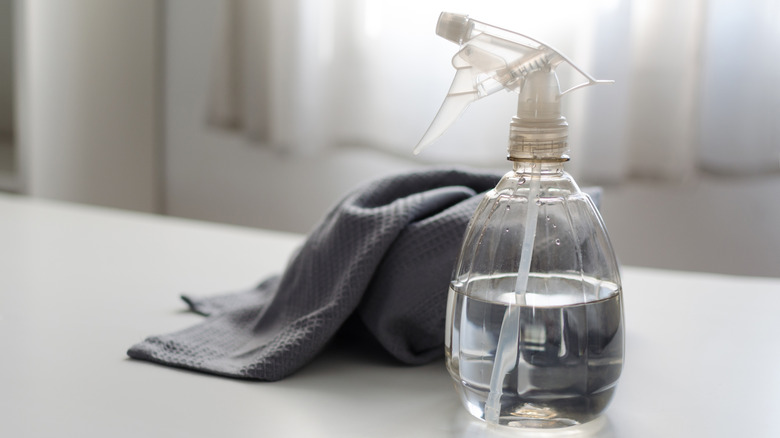The Biggest Downside To Cleaning With Vinegar
Vinegar is a wildly popular ingredient to keep your home clean and for good reason. Its ability to cut through anything grimy, sticky, dirty, or gunky has earned it a place in our cleaning hall of fame. But there is one major downside to cleaning with vinegar you should know: it's not a disinfectant.
We know, we know. There's a lot of chatter out there about how vinegar is a versatile cleaner that can take down both dirt and bacteria. Studies show that vinegar's main ingredient, acetic acid, can kill some bacteria. However, it typically only eliminates about 80% of germs. While this is helpful, that leftover 20% is more than enough to spread disease. Simply put, the acid's concentration in everyday household vinegar just isn't high enough to kill off the 99.9% of bacteria and viruses the U.S. Environmental Protection Agency requires to be labeled a disinfectant.
Does that mean you need to toss out your DIY vinegar cleaning solutions? Absolutely not. As long as you don't use it on certain materials — think hardwood floors, unsealed grout, or natural stone — vinegar can help keep your home clean and sparkling. But if you need to disinfect, there's a few other household items that can help.
What to use to disinfect instead of distilled white vinegar
So if you can't use vinegar to disinfect, does that mean you have to turn to store-bought, chemical-laden products? Nope. There are three common items you probably already have in your house you can swap it out with for a more powerful disinfectant: hydrogen peroxide, rubbing alcohol, and bleach.
That 3% strength hydrogen peroxide that's lingering in your first-aid kit is a great, inexpensive disinfectant you can use throughout your home. Mix one part of hydrogen peroxide with one part water and apply to a clean surface. Wait five minutes, then rinse if needed (especially if the surface is anywhere that will come in contact with food) or just let dry. Rubbing alcohol can take viruses and fungi head on, but is not as effective against bacterial spores. To use, simply dip a clean cloth in the liquid and wipe the item.
The last option is one of the most well-known: plain, unscented household bleach with 5 to 9% sodium hypochlorite. The CDC advises to not use a bleach product outside of that range or if there's no range listed. Many bleach containers include instructions for disinfecting; follow these carefully to make and apply the solution. There are a few precautions to take if you choose to use bleach in your home, namely diluting it with water only. And when disinfecting with bleach or any other disinfectant — store-bought or otherwise — make sure the space has good ventilation and you're wearing the right personal protective equipment, like safety glasses and gloves.

